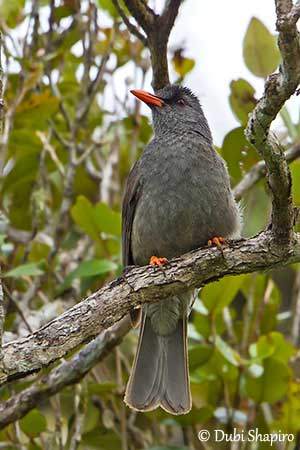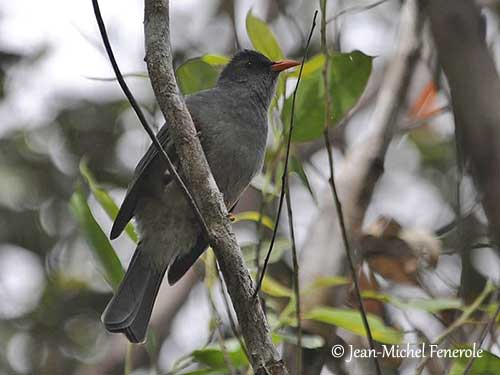
REPRODUCTION OF THIS SPECIES:
The breeding season takes place between November and February.
The Mauritius Bulbul is monogamous. The female builds the nest, a coarse cup made with twigs, grasses, leaves, roots, moss and lichens, with a softer lining inside. This structure is placed between 2 and 9 metres above the ground in bush or tree.
The female lays 2-3 pinkish-white eggs with brown markings. The incubation lasts 14-16 days and might be shared by both adults, but it is presumed by female only. The chicks may be fed by both parents during three weeks, or only by female. They usually remain in family group for some days or weeks, even when they are able to feed themselves.
They are vulnerable to predation by introduced Rattus rattus and Macaca fascicularis.
PROTECTION / THREATS / STATUS:
The Mauritius Bulbul is threatened by degradation and loss of suitable habitat caused by invasion of exotic plant species. This is the main threat for the future of this species.
Introduced Rattus rattus, Macaca fascicularis, Common Myna and Red-whiskered Bulbul are also important threats for both adults and young.
The Mauritius Bulbul is restricted to native forest, but it can be seen in degraded forest remnants, secondary scrubs and exotic plantations.
Conservation actions underway include rehabilitation of native ecosystems, exclusion of introduced animals and control of exotic plants replaced by native species.
The population was estimated to number 560 mature individuals in 1993, equating roughly 840 individuals. The species is suspected to be increasing in some areas and decreasing in others.
The Mauritius Bulbul is currently listed as Vulnerable.
Fr: Bulbul de Maurice
Ang: Mauritius Bulbul - Mauritius Black Bulbul
All: Mauritiusbülbül
Esp: Bulbul de Mauricio
Ita: Bulbul di Mauritius
Nd: Mauritiusbuulbuul
Sd: mauritiusbulbyl
Photographers:
Jean Michel Fenerole
Photos d’Oiseaux du monde
Dubi Shapiro
Dubi Shapiro Photo Galleries & Dubi Shapiro's Pictures on IBC
Text by Nicole Bouglouan
Sources:
HANDBOOK OF THE BIRDS OF THE WORLD Vol 10 by Josep del Hoyo-Andrew Elliott-David Christie - Lynx Edicions - ISBN: 8487334725
The Birds of Africa: Volume VIII: The Malagasy Region: Madagascar, Seychelles, Comoros, Mascarenes - Par Roger Safford, Frank Hawkins – ISBN: 1408190494, 9781408190494- Editeur: A&C Black, 2013
Birds of Madagascar and the Indian Ocean Islands Par Roger Safford, Adrian Skerrett, Frank Hawkins – ISBN: 1472924118, 9781472924117- Editeur: Bloomsbury Publishing, 2015
Fiche « patrimoine naturel à protéger » Le Merle noir ou Bulbul de Maurice Hypsipetes olivaceus
Wikipedia, the free encyclopaedia
Home page
Page Passeriformes Order
Mauritius Bulbul
Hypsipetes olivaceus
Passeriformes Order – Family Pycnonotidae
INTRODUCTION:
The Mauritius Bulbul is endemic to Mauritius Island where it frequents native forest and adjacent exotic vegetation. It feeds on fruits, animal prey, insects, and occasionally consumes flowers and nectar. It breeds during the southern summer and often uses the same territory in several following years. It is resident and monogamous.
The Mauritius Bulbul is threatened by degradation and loss of the habitat, nest predation by introduced mammals and competition with Common Myna and Red-whiskered Bulbul. It is now confined to the remnants of the native forest.
DESCRIPTION OF THE BIRD:
Biometrics:
Length: 25-27 cm
Weight: M: 69 g – F: 76 g
The Mauritius Bulbul has dark greenish-olive upperparts with brownish streaks, but the rump is slightly browner. Uppertail and upperwing are olive-brown with secondary and tertials finely edged greenish-grey. The hindneck is dull olive-grey with darker streaks.
On the underparts, throat, breast and flanks are dark greenish-grey, whereas the belly is mostly yellowish-grey and the rear flanks are pale cinnamon. The undertail-coverts are dull yellowish.

On the head, forehead, crown and nape are dark olive-green to blackish. Lores are blackish too. Cheeks, ear-coverts and rear sides of hindcrown are greenish olive-grey.
The bill is orange and slightly decurved. The eyes are dark chestnut. Legs and feet are orange-yellow.
Male and female are similar.
The juvenile is mostly greyish-brown with brighter brown flight-feathers. The bare parts are dull and dark.
RANGE:
The Mauritius Bulbul is found on Mauritius in SW, central and SE of the island.
HABITAT:
The Mauritius Bulbul frequents the restricted areas of native forest and the nearby exotic vegetation. It is mainly found in uplands around 200 metres of elevation, rarely lower.
CALLS AND SONGS: SOUNDS BY XENO-CANTO
The Mauritius Bulbul is a noisy bird. We can hear several types of calls, including a chuckle “chuck chuck”, a “cat call”, a “kek” when alarmed and some soft notes used as contact calls between mates.
The “chuck chuck” often varies with context, but it is part of a simple song given by the territorial male, and also used between both mates while foraging in pairs or within groups. The “cat call” is a raucous “nyeer” clearly defined. During aggressive behaviour, it gives a “kek”.
BEHAVIOUR IN THE WILD:
The Mauritius Bulbul is arboreal and feeds primarily on insects, seeds and fruits, especially the ripe berries of non-native Lantana camara. It occasionally takes flowers and nectar. Animal prey include arboreal insects, spiders and diurnal geckos of genus Phelsuma.
The Mauritius Bulbul forages exclusively in trees by gleaning prey from leaves, twigs and branches, and it may perform a clumsy flycatching. The larger prey are held in the bill and beaten against branches before to be swallowed.
The Mauritius Bulbul is monogamous and the same territory is usually occupied year after year. Both adults strongly defend the site.
Courtship by male involves aerial display to the female, with rapid, exaggerated wingbeats. The tail is raised and slightly fanned. It gives several “chuck chuck” notes with the head thrown back. The nest is built by the female.
The Mauritius Bulbul is resident on Mauritius. Outside of nesting period, it disperses widely and may occur in scattered localities.
The flight is strong and undulating like in other bulbuls. It often flies above the canopy and easily flies through branches and foliage.
